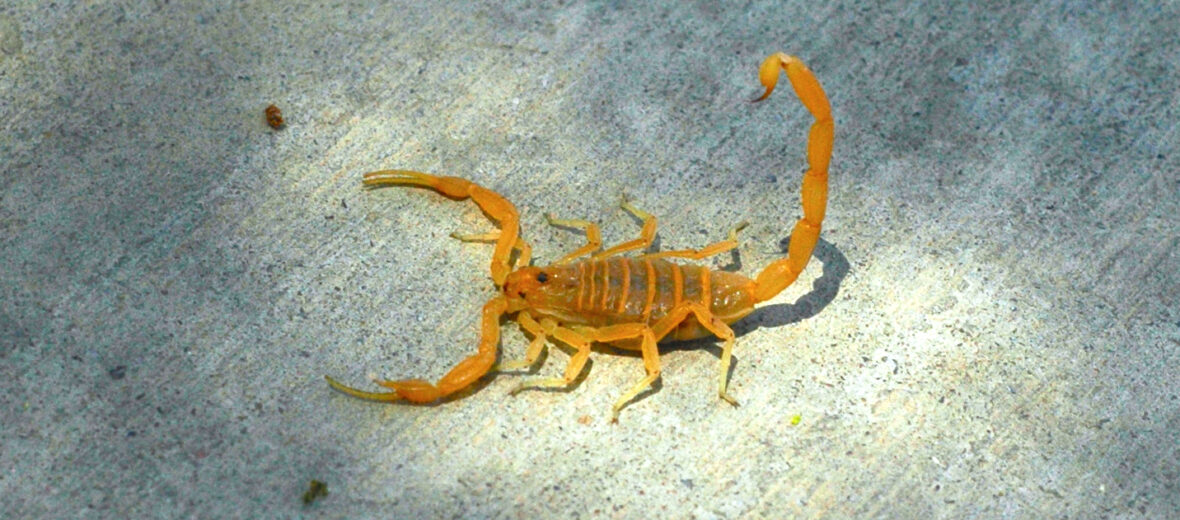
The Arizona bark scorpion can be found from southern California, throughout southern Arizona, into the western parts of New Mexico, the southern parts of Utah, and in Mexico (notably in Baja California, Chihuahua, Mexico, and Sonora Mexico). In the wild, they prefer to hide in rocky crevices, leaf litter, and a variety of dark crawl spaces. In urban and suburban areas, they prefer to hide in water meters, under home foundations, in the smallest of openings in houses, under sinks, in clothing left on the floor, and in your bed. Yeah, I had to go there; just to creep you out. Most people, in Arizona, use shoes or flip flops to walk around in their houses at night; to avoid stepping on one. I’ve been stung several times by them and it will wake you up at night. My first sting was in my bed, under my sheets, right in the butt. I also have a friend who was stung someplace no man would ever want to be stung. Let’s leave it at that.
First the Stats…
Scientific name: Centruroides sculpturatus
Length: Up to 3 inches
Lifespan: Up to 6 years
Now on to the Facts!
1.) Bark scorpions, like other scorpions, are nocturnal (active at night).
2.) These scorpions like to eat spiders, insects, centipedes, other scorpions, and even each other.
3.) They are preyed upon by tarantulas, centipedes, lizards, birds (like owls), and mammals like shrews, bats, grasshopper mice, and your local exterminator.
4.) In colder winter months, they will estivate (hibernation for arthropods) and in residences they will do so in your home. Say hello to your new roommate(s).
5.) While most scorpions are solitary, the Arizona bark scorpions congregate in groups of 20 – 30, or more! Where there is 1, there will be many!
But wait, there’s more on bark scorpion!
6.) Their hard, waxy exoskeleton helps make them resistant to water loss. They can go for months without water, gaining a majority of moisture from the prey they consume.
7.) The bark scorpion is the only medically significant scorpion in North America.
Did you know…?
All scorpions will fluoresce under an ultraviolet light. Even their freshly molted exoskeletons will glow for a while too. It is still debated as to why they do this. It is suspected that they use this feature to help locate a mate.
8.) The venom of a bark scorpion can cause severe pain, numbness, tingling, drooling, nausea, and vomiting in adult humans. This typically lasts between 24 – 72 hours. Temporary loss of function in the area stung is possible. It also may cause loss of breath for a short time. Due to the extreme pain experienced, some sting victims talk of sensations of “electrical jolts” after envenomation. The numbness can last for several days.
9.) Small animals like cats and dogs, young children, the elderly, and adults with compromised immune systems are at greatest risk of serious effects and even death (although this is rare). Extreme reaction to the venom is described as numbness, paralysis, frothing at the mouth, and a neuromotor syndrome that can be confused with a seizure with difficulty breathing, particularly in young children and smaller pets.
10.) Antivenom was first created by Arizona State University’s by Dr. Herbert L. Stahnke, but this never got FDA approval and was later discontinued. Later a Mexican-produced antivenom, Anascorp received FDA approval on August 3, 2011, and is now in wide-spread use. It is very expensive though! The scorpion antivenom Anascorp, is sold in Arizona these days for $12,000+ per vial, meaning 1 course of treatment could cost as much as $62,000!
But wait, there’s still more on bark scorpion!
11.) The last known death to occur from an Arizona bark scorpion sting was in 1948.
12.) Females give birth to 20 – 30 live young that migrate onto their mother’s back for a week or 2, till they molt a couple times; in order to gain their hardened exoskeleton. Then they leave or risk being eaten by mom. Mother of the year, eh?
Did you know…?
Scorpion venom is the most expensive liquid in the world. It can yield up to $39,000,000 a gallon!
13.) They also like to climb, unlike other scorpions that are typically terrestrial (spend most or all of their time on the ground) and can be found upside down under debris and indoors, in a position known as negative geotaxis.
14.) Scorpions are arachnids, but not spiders. The classification of arachnid can be described as 2 body segments, 8 legs, 2 pendipalps (arm-like appendages attached to the cephalothorax – body), and multiple eyes.
15.) Like most arachnids, they also have relatively poor vision, despite having multiple eyes, and thus rely on their ability to sense vibrations. The hairs on their body help them with this ability.
Now a Short Arizona Bark Scorpion Video!
Also, check out the Critter Science YouTube channel. Videos added frequently!
Want to suggest a critter for me to write about? Let me know here.



